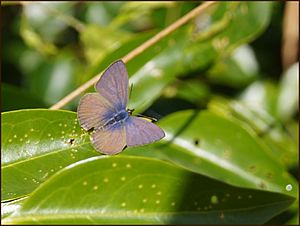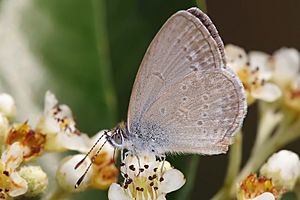Common grass blue facts for kids
Quick facts for kids Common grass blue |
|
|---|---|
 |
|
| This specimen, perched on a rose, is approximately 10 mm in size | |
 |
|
| At Cape Hillsborough National Park, Australia | |
| Scientific classification | |
| Subspecies | |
|
The Common Grass Blue (scientific name: Zizina labradus) is a small, pretty butterfly. It is also known as the grass blue or clover blue. This butterfly belongs to the Lycaenidae family. You can find it in Australia.
Contents
What Does the Common Grass Blue Look Like?

Adult Common Grass Blue butterflies have beautiful purplish-blue upper wings. Their bodies are black. The edges of their wings are black or brown. Female butterflies have wider dark edges than males.
The underside of their wings is brown or pale brownish-grey. It has a pattern of fawn-colored bands and spots. Their bodies are covered in white or grey hairs. Female butterflies are slightly larger than males. Females have a wingspan of about 23 mm. Males have a wingspan of about 20 mm.
These butterflies have a gentle, fluttering flight. They usually fly close to the ground. This helps them stay near their food sources.
Eggs, Caterpillars, and Pupae
The eggs of the Common Grass Blue are white or pale blue. They are shaped like a tiny, round mandarin orange. Their surface has small pits.
When they hatch, the caterpillars are about 7 mm long. They are mostly green. They have a yellow stripe along their sides. A darker green stripe runs down their back. Their heads are usually brown or black. The head is often hidden under their body.
The pupae are about 10 mm long. They have tiny hairs that stand up. Their color can vary. They might be pink, greyish, or greenish-cream. They also have mottled dark spots.
Where Do Common Grass Blues Live?
The Common Grass Blue butterfly is found in many places. One type, Zizina labradus labradus, lives across most of Australia. You can also find it on Lord Howe Island, Norfolk Island, and Christmas Island.
Another type, Zizina labradus labdalon, mainly lives in the Cape York Peninsula. Sometimes, people confuse the Common Grass Blue with a similar butterfly. This is the Lesser Grass Blue (Zizina otis).
As its name suggests, the Zizina labradus labradus is very common. You can often see it in suburban gardens. It likes to perch in grassy areas, lawns, and fields.
How Do Common Grass Blues Grow?
Female butterflies lay single eggs. These eggs hatch in just a few days. The eggs are laid on the leaves, stems, or flower buds of plants. They also lay them on young pods of food plants.
These food plants are usually legumes. Legumes are plants from the Fabaceae family. Examples include beans, clover, and various native plants.
Caterpillar Life
When they first hatch, the tiny caterpillars eat small holes in young leaves or flower buds. As they grow, they mainly feed inside flowers. Sometimes, they are considered a minor pest. This is because they can eat garden beans. They make a small hole in the pods. Then they eat the soft seeds inside.
Interestingly, larger caterpillars are sometimes attended by ants. These ants belong to groups like Paratrechina, Rhytidoponera, and Tapinoma. The ants might protect the caterpillars.
Pupa Stage
When a caterpillar is ready to become a pupa, it attaches itself to the underside of a plant leaf. It uses hooks at its end to hold on. It also uses a central "girdle" or band to stay in place.

